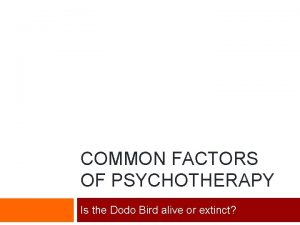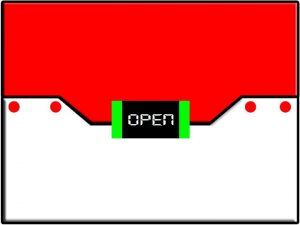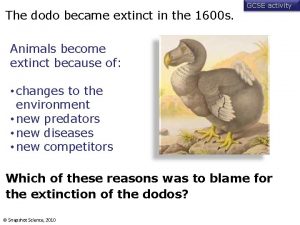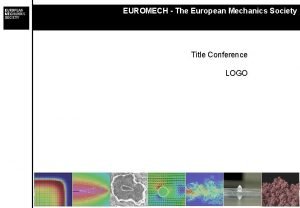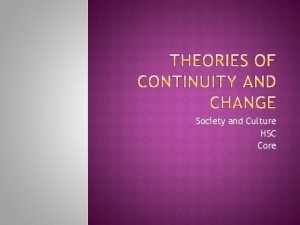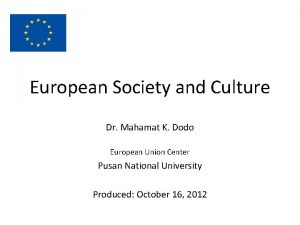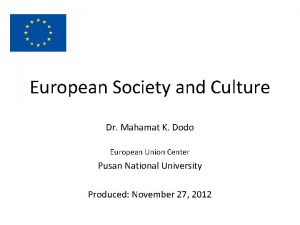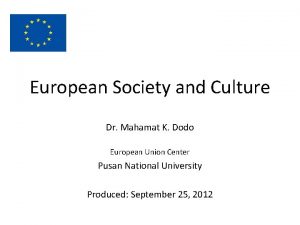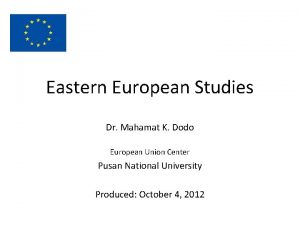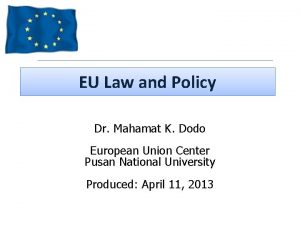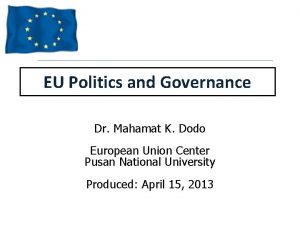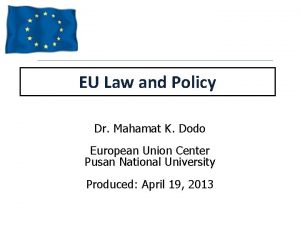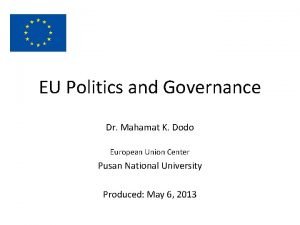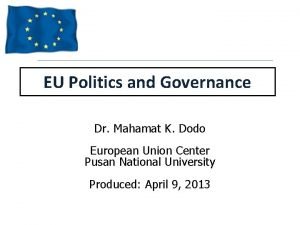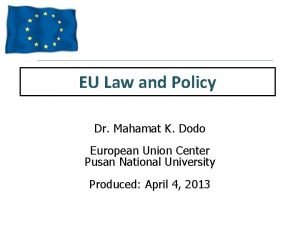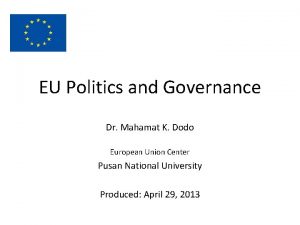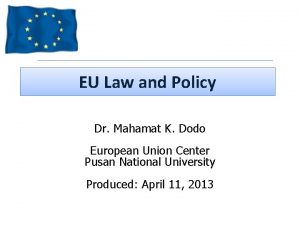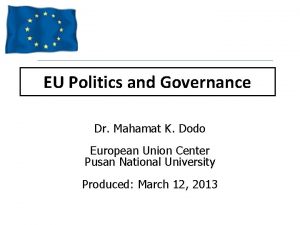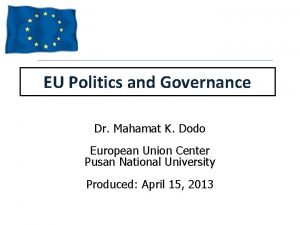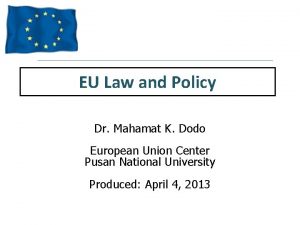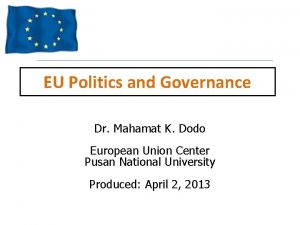European Society and Culture Dr Mahamat K Dodo

















- Slides: 17

European Society and Culture Dr. Mahamat K. Dodo European Union Center Pusan National University Produced: September 19, 2012

Theorizing European Integration Some Perspectives on Some Theories of the European Integration 1) To arrive at a definite conclusion on theory explaining the development of European integration will lead to disappointment 2) Recent Trends within the academic circles have been towards less ´Grand Theories´ and dogmatic explanations of events and processes 3) Thus, the future of the European Union cannot confidently be predictable 4) The new theoretical approach in explaining the European integration puts more emphasis than earlier theories on the choices available to the Member States and upon the influence of international events and circumstances 5) The newer theories on the European integration though, draw upon various schools of thought than the old theories, they tend to use conceptual lenses derived from their own academic fields September 19 , 2012 Dr. Mahamat K. Dodo (PNU EU Center)

Some Perspectives on Some Theories of the European Integration 6) As an example, the international relations scholars have clearly had a major influence on EU theorizing 7) Also, in recent years, scholars from the study of comparative government and politics have made significant contributions to integration theory as well, by making use of the conceptual lenses developed in the study of national political systems in their analyses of the European Union for instance, 8) Historically, the early theories of the European integration were all ´Grand Theories´, they thought to provide a comprehensive explanation of the nature and development of European integration 9) In recent years, the newer theories have tended to provide middle range theories that focus on specific questions of the European integration 10)There an increasing number of these theories, that means, the study of the EU theorizing is becoming fairly fragmented within the academic circles and policy-making community at large September 19, 2012 Dr. Mahamat K. Dodo (PNU EU Center)

The following are the most widely discussed theories of the European integration Functionalism Functionalists favor gradual transfer of sovereignty from national to supranational entity (see here European Community) ► The fundamental philosophy of the functionalists is to gradually undermine state sovereignty by encouraging technical cooperation in specific areas of the national economy (see ECSC case) ► Jean Monnet favored this approach of gradually and incrementally transferring national powers to supranational authorities, this sectoral integration was seen as an alternative to the federalist ´Big Bang´s approach ► The rationale behind the functionalist philosophy was its opposition to nationalism David Miltrany (the father of functionalism) regarded nationalism as the biggest threat to world peace and so, favored a shift in human loyalties from national to international level. In his view, this could be accomplished through mutually international cooperation in sectors such as transportation, agriculture and science and health. September 19, 2012 Dr. Mahamat K. Dodo (PNU EU Center)

Functionalism ► His ideas were basically rooted in the assumptions that national governments are less able to meet the welfare of their respective citizens than non-political international authorities He favored what he called technical self-determination over national self-determination Professor Miltrany believed that human loyalties would shift from the nation state to the supranational entities because of the concrete material benefits that those entities would provide them. However, he favored global cooperation rather than regional cooperation as advocated by Jean Monnet and the other founding fathers of the European integration (global vs regional views) Shortcomings of the Functionalist Approach ► Proponents of the functionalist theory overlooked the role that politics play in regional as well as international organizations such as UNESCO (mm) or ILO (International Labor Organization) for instance, ► They also overlooked the role that states play in regional and international organizations September 19, 2012 Dr. Mahamat K. Dodo (PNU EU Center)

Neo-Functionalism The new theory was developed in the ´ 50 s and ´ 60 s to explain the integration processes in the European Community. ► The founding fathers of this approach were all Americans (Ernst B. Haas, Joseph S. Nye and Leon N. Lindberg). ► Haas viewed integration as a developing and evolving process involving bargaining and compromise like other forms of politics. ► Spillover effects (experience of cooperation in some fields could lead of cooperation in other fields) ► But this will not be automatic, there will be a learning curve for that to happen September 19, 2012 Dr. Mahamat K. Dodo (PNU EU Center)

Main Differences between Functionalism and Neo-Functionalism For proponents of neo-functionalism, the role of governments and the political dimension of the integration processes are fully taken into account ► Functional cooperation can only take place if the participating governments agree to take part in it ► Unlike the functionalists, neo-functionalists accept the importance of political conflicts between the competing and cooperating governments because of the existing competing interests among them ► Neo-functionalists also emphasized the importance of elites and elite bargaining and socialization rather than mass public support for integration in its early stage ► Neo-functionalists also benefited from a stronger empirical foundation (functionalism) and sought to explain in some detail how a specific integration process works (Grand Theory) ► Neo-functionalists also focused upon integration between a group of countries in specific region of the world (European regional integration) rather than global integration as foreseen by the Functionalists. September 19, 2012 Dr. Mahamat K. Dodo (PNU EU Center)

Weaknesses of the Neo-Functionalist Approach as seen by Haas Spillback (reverse integration) and unpropitious conditions at a later stage of European integration ► Unpropitious conditions at a later stage of European integration ► Limited spillover cases in the integration process (exception being in agricultural policy) ► Underestimation of the power of nationalism and the influence of external factors (international events) ► Recognition of the complexity of the European integration, thus, no single theoretical model can explain it all However, the completion of the Single European Act and the signing of the Treaty on European Union have brought new interests in revisiting the neo-functionalists ideas of spillover prediction Scholars such as Keohane and Hoffman though, did not agree with that assertion, they argued that happened because of the combination of external factors: that is, the convergence of national interests, the lack of competitiveness of the European economy and the development of the globalized economy September 19, 2012 Dr. Mahamat K. Dodo (PNU EU Center)

Federalism Their main approach was to create powerful institutions (an executive, a parliament and a court) above the level of the nation-state, they favored a transfer of substantial degree of state sovereignty to supranational institutions ► The federalists favored the ‘bing bang’ approach to redesign Europe, that is, a frontal assault on sovereignty ► The federalist plan was undermined by the governmental power and the loyalties of citizens to their own nation-states Main proponents of the European federalism during and after the war were Altiero Spinelli and Ernesto Rossi (political prisoners confined by Benito Mussolini) Contemporary Federalists (referred to as Neo. Federalists) They are more realistic in their aspirations than their predecessors, their approach is more of gradual and incremental steps in building a federal union rather than doing it all at once ► Main proponents of this approach are: Former German Minister of external affairs, Joschka Fischer, and former German Chancellor Gerhard Schroder September 19, 2012 Dr. Mahamat K. Dodo (PNU EU Center)

Intergovernmentalism This is an approach that stresses the role of governments in European integration processes That is, it mainly seeks for closer cooperation between national governments and puts more decision powers in the hands of the member states. There are two strands of intergovernmentalism: Prescriptive intergovernmentalism ► Adherents to that approach are of the view that governments should be the dominant actors in the Union Descriptive intergovernmentalism ► Proponents of this approach simply are of the view that governments are, for good or bad, the key actors in the Union They make their points by showing the differences between the Union and other international organizations such as the OECD and NATO They argue that the Union has supranational institutions of considerable importance and the binding majority voting in the council of the EU for instance, differentiates the Union from other international organizations September 19, 2012 Dr. Mahamat K. Dodo (PNU EU Center)

Key Differences between Prescriptive and Descriptive Intergovernmentalism Proponents of the prescriptive intergovernmentalism seek to oppose attempts to enhance the powers of the Union´s supranational institutions such as the Commission or the Court of Justice ► They favor a club of states type of union ► Proponents of descriptive intergovernmentalism on the other hand, downplay the role of supranational institutions and cite the important role played in EU policymaking by the Council, the European Council and a support network of intergovernmental advisory committees ► They cite examples of convergence of interests and dominance of the states such as the Franco-German axis as the driving force behind the European integration September 19, 2012 Dr. Mahamat K. Dodo (PNU EU Center)

Liberal Intergovernmentalism This is an example of descriptive intergovernmentalism developed by Andrew Moravcsik ► The main theoretical approach of liberal intergovernmentalism is that if focuses on the interplay between domestic and international politics ► According to Mr. Moravcshik, EU policy process is mainly centered around intergovernmental bargaining and supranational actors are not as strong as they seem ► He also argues that the EU is as a regime is conceived to manage economic interdependence through negotiated policy bargaining and coordination ► He further argues that economic interests within the EU member states are the real driving forces in shaping the preferences of the governments of the EU citizens Weaknesses of liberal intergovernmentalism ► Liberal intergovernmentalism is Too selective with empirical references ► Liberal intergovernmentalism displays a narrow concept of the State ► Liberal intergovernmentalism downplays the roles of supranational institutions September 19, 2012 Dr. Mahamat K. Dodo (PNU EU Center)

Policy Network This approach presents the mutual interdependency that exists between the national governments and various interests groups ► It involves interaction, mediation, negotiation, bargaining and collaboration between groups of actors with disparate and common interests in the policy process ► Actors here mean national governments, Union institutions, interest groups such as agricultural, environmental or business lobbies ► Governments are still the dominant players in policy network analyses, however, they allow organized interests into the policy process because of their knowledge, expertise and advice that supranational institutions such as the Commission and the Council need in their policy formulation and decision-making ► Policy network approach attempts to comprehensively present how is policy made in the Union and who are the diverse actors involved in the policymaking at national as well as EU level September 19, 2012 Dr. Mahamat K. Dodo (PNU EU Center)

Multilevel Governance The multilevel governance is an approach that seeks to explain the interrelationships between the levels of government in the European Union, that is, supranational, national and subnational and how the actors at these levels interact ► According to the multilevel governance hypothesis, the influence of all actors, be it supranational, subnational (local and regional) must be taken into consideration when analyzing EU policymaking ► Multilevel governance approach recognizes that governance at the national level remains the most important element in this interplay of different levels of governance Debate Concerning the Validity of the Multilevel Governance Hypothesis 1) How powerful are the supranational and subnational levels? 2) Are supranational and subnational controlled by the national level? September 19, 2012 Dr. Mahamat K. Dodo (PNU EU Center)

New Institutionalism Unlike the institutionalist approach of the past, the new institutionalism embraces formal and informal institutions and incorporates values, cultural norms, conventions, symbols and many other characteristics ► It seeks to explain broadly how institutions influence the behaviors of the policymakers and affect the policy outcomes ► Proponents of the new institutionalism think their approach can help explain the behaviors of policymakers in the EU and why those policymakers make specific policy choices September 19, 2012 Dr. Mahamat K. Dodo (PNU EU Center)

Three Categories of the New Institutionalism ► Historical Institutionalism (institutions have history) ►Rational Institutionalism (actors are self-interested and institutions shape their behaviors) ► Sociological Institutionalism (institutional conventions and norms) Main Weakness of the New Institutionalism According to Its Critics Proponents of the new institutionalism have a tendency of defining ´institution´ broadly and it encompasses almost everything September 19, 2012 Dr. Mahamat K. Dodo (PNU EU Center)

Thank you for your time and attention September 19, 2012 Dr. Mahamat K. Dodo (PNU EU Center)
 Dodo passenger pigeon and stellers
Dodo passenger pigeon and stellers Dodo effect psychotherapy
Dodo effect psychotherapy The dinosaur and the dodo bird
The dinosaur and the dodo bird Grassland
Grassland Dodo kuşu nesli ne zaman tükendi
Dodo kuşu nesli ne zaman tükendi Satuan besaran pokok sisi kubus
Satuan besaran pokok sisi kubus Dodo akan memberi kado ulang tahun buat desi
Dodo akan memberi kado ulang tahun buat desi Dodo bird
Dodo bird Dodo meme
Dodo meme Sefi
Sefi European mechanics society
European mechanics society Explain how the printing revolution shaped european society
Explain how the printing revolution shaped european society Hsc society and culture
Hsc society and culture Hsc society and culture
Hsc society and culture Society and culture pip
Society and culture pip Culture and society are intricately related
Culture and society are intricately related Viking hierarchy
Viking hierarchy Chapter 3 society and culture in provincial america notes
Chapter 3 society and culture in provincial america notes

